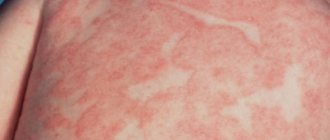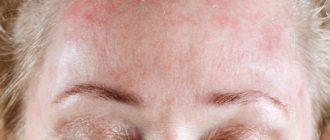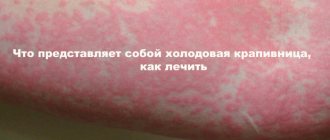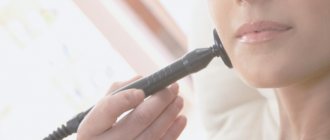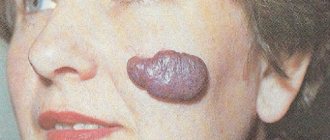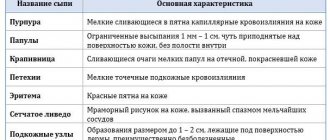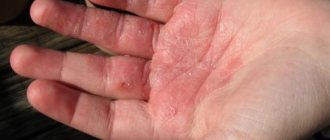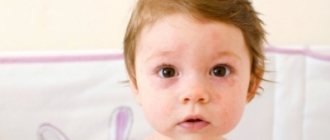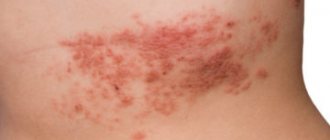Most parents are familiar with the manifestations of such an unpleasant symptom as urticaria in their child. It often occurs in an acute form, especially in newborns, and goes away quite quickly on its own. As a rule, a rash resembling nettle burns is accompanied by itching, and in severe cases, angioedema. To choose the appropriate treatment, you must consult a pediatrician. In addition, you need to know how to treat urticaria in children at home in order to alleviate their condition in the shortest possible time.
How to recognize the disease?
Urticaria is a rapidly developing pathological reaction of the body in association with an allergen. The disease implies the initial form of the mechanism of tissue swelling, which occurs as a result of the intense release of biological substances (histamines) into the bloodstream. There are acute and chronic forms. The pathology is not only skin, many organ systems are involved in the process, including the digestive and nervous.
Urticaria can be recognized by the following signs:
- red rashes or blisters with outlined lines form anywhere (stomach, back, buttocks, arms, legs);
- diameter - 2 mm-2 cm;
- when pressed, the bubble turns white;
- It happens that within a day the rash disappears and appears in other places;
- formations provoke itching and burning, intensifying at night.
In difficult situations, the clinical picture is complemented by an increase in body temperature, nausea, vomiting, and discomfort in the joints and muscles.
Symptoms requiring immediate attention:
- difficulty inhaling and exhaling;
- loss of consciousness;
- severe barking cough, hoarseness of voice;
- increased heart rate, rapid pulsation;
- sudden drop in blood pressure;
- chills, convulsions, tremors;
- feeling of throat constriction, difficulty swallowing;
- darkness in the eyes;
- feeling of timidity, fear;
- stopping breathing.
If children have signs of urticaria, emergency assistance is needed to carry out emergency measures. After all, a complication of urticaria can be Quincke's edema, anaphylactic shock.
Symptoms
The most common symptom is red, itchy welts or blisters , often all over the child's body. Scars can vary in size from a few millimeters in diameter to 20 centimeters . Treatment of urticaria in a child at home with such symptoms is possible without the intervention of a specialist.
Other symptoms include:
- tingling or burning of the affected areas;
- soreness;
- labored breathing;
- dizziness (rarely: fainting);
- anxiety, stress;
- swelling of other parts of the body, including the mouth, hands, eyes, legs, or genitals.
Sometimes urticaria can be accompanied by other diseases that cause high fever, nausea, diarrhea, and sore throat. If these symptoms persist or cause severe discomfort, it is important to contact your child's doctor .
First aid for hives
When a rash occurs in children, the first action is to eliminate the allergen or extremely limit contact with it. If food is the cause, the stomach should be rinsed. If you are allergic to chemicals, cosmetics, or matter, take a shower; if you are allergic to medications, stop using them and replace them with others.
Timely provision of first-aid to a child with urticaria is of great importance in preventing the worsening of the disease.
If urticaria occurs in children: emergency care, the algorithm of actions is as follows:
- When initial signs of manifestation occur, it is important to assess the patient’s condition.
If a single rash is localized, it is slightly itchy and does not enlarge subsequently, it is enough to treat the area with an allergic ointment (Fenistil, Zinc). The drugs effectively eliminate itching and have a drying, astringent effect. Also give him an antihistamine tablet.
- Drink enterosorbent (Polysorb, Activated carbon). Sometimes, the use of fast-acting laxatives (Magnesium sulfate) becomes an effective measure. However, it is necessary to replace the lost fluid.
- A preventive measure for anaphylaxis at the time of an insect bite is the immediate removal of the sting and prevention of the distribution of poison into the blood. Place ice on the bite area. When there is a history of complex allergic manifestations, take an antihistamine (Suprastin, Diazolin).
First aid for rashes and its complications is performed depending on individual symptoms. Therefore, eliminating weak signs of disease with strong doses of steroid medications is very unwise and dangerous.
Reasons for appearance
Urticaria most often has an allergic origin.
The rash may be a reaction to:
- Irritants in contact with the skin (cosmetics, detergents and detergents).
- Food products - cow's milk and products made from it, strawberries, oranges, tangerines, chicken eggs, nuts, canned food, smoked meats, honey. As well as breast milk from a mother who has eaten something that causes an allergy in the baby.
- Irritants that enter the air - pollen, smoke from cigarettes, fumes from household synthetic products.
- Medications.
- Infections of bacterial or viral origin (adnexitis, tonsillitis, caries).
- Poison that enters the body after an insect bite.
- Presence of worms.
- Some physical irritants are cold, heat, excessive sunlight.
Related factors
Chronic urticaria can be a consequence of ailments that already exist in the body:
- thyroid diseases;
- leukemia and tumors;
- liver problems;
- autoimmune disorders;
- disruptions of the gastrointestinal tract (gastrointestinal tract).
Nursing care for urticaria
Before medical help arrives, you need to:
- put the baby on his back;
- place your legs above the horizontal surface;
- open your mouth slightly to avoid sticking your tongue and swallowing possible vomit;
- provide the patient with fresh air.
In case of cardiac arrest, perform resuscitation actions on your own: indirect massage of a vital organ, mouth-to-mouth artificial respiration.
The protocol for providing emergency care by a nurse involves the following algorithm of action:
- stop contact with the allergen;
- guarantee physical and psychological comfort;
- prepare the necessary instruments, establish the possibility of acceptable IV administration of the drug;
- inject the child or give him to drink (depending on the severity) an antihistamine (Suprastin, Claritin);
- perform treatment with enterosorbents;
- if there are no favorable dynamics, administer Prednisolone 3% 1-2 mg/kg intramuscularly;
- for anaphylaxis - administration of Adrenaline.
If you experience a food allergic reaction, the symptoms of which quickly increase, you need to rinse the stomach by artificially induced vomiting. But this action is carried out only in the absence of swelling of the throat, otherwise aspiration of vomit is possible.
Video
In the video, Dr. Komarovsky talks about the treatment of urticaria. Filmed by the channel “Inter TV channel”
Do you have any questions? Specialists and readers of the KROHABABY website will help you ask a question
Was this article helpful?
Thank you for your opinion!
The article was useful. Please share the information with your friends.
Yes (100.00%)
No
X
Please write what is wrong and leave recommendations on the article
Cancel reply
Rate the benefit of the article: Rate the author ( 1 vote(s), average: 5.00 out of 5)
Discuss the article:
Treatment of urticaria in children
Therapy for urticaria begins with identifying and preventing the factors that cause its appearance, and subsequently lead to an exacerbation of the disease. The fight against pathology also involves taking measures aimed at reducing symptoms and strengthening the human immune system.
For the disease, the following treatment methods are used:
- use of pharmacological drugs (tablets, injections);
- treatment of the pathological area with local agents (ointments, creams);
- compliance with dietary nutrition;
- physiotherapy.
Tablets are usually used in the treatment of chronic urticaria, when the acute period has passed. Injections are necessary at the time of first aid, as well as in the acute phase of the disease.
For urticaria, a wide range of medications are prescribed in the form of tablets, injections, and ointments.
The child needs to drink more fluids. You can prepare an alkaline solution: add 1 g of baking soda to 1 liter of water. The use of mineral water without gases with a slightly alkaline composition is allowed.
Injections and pills
The following drugs are often used by injection:
- Adrenalin
- indispensable as first aid for symptoms of urticaria. Give 1 ml intramuscularly, a second injection is possible after 5-10 minutes. after the first one. Exhibits a vasoconstrictor effect, preventing vascular collapse. Normalizes blood circulation, blood pressure and heart muscle function. - Suprastin
— recommended in the subacute period of pathology. Directions for use: 1 ml intramuscularly 2-3 times a day. - Diphenhydramine
- first aid for urticaria. Used intramuscularly, 1 bottle in the evening. Negative effects: drowsiness, sedative effect on the central nervous system. This is a first generation antihistamine with a pronounced antiallergic result. - Fenkarol
- effective for allergies, urticaria, Quincke's edema. Dosage: 2 ml 2 times a day for 5 days.
The tablet form of drugs is mainly used in the subacute period. The following antihistamines are prescribed:
- Tavegil
- has an antipruritic effect, reduces vascular permeability, stops exudation and the formation of edema. For children 6-12 years old, the dose is ? — 1 tab. before meals 2 times a day. - Diazolin
- exhibits antiallergic, antiexudative effect. Take 1 tablet. twice a day. - Trexyl
- indications for use are dermatological diseases, food and drug allergies. - Zyrtec
- reduces smooth muscle spasm, capillary permeability, and prevents swelling. The daily dosage of the drug is 1 tablet.
Anti-urticaria tablets can be replaced with drops.
Ointments and gels
External medications are divided into 2 groups - hormonal and non-hormonal. Regardless of the components, the ointments are applied as follows:
- thin layer;
- only on inflammatory areas;
- following the instructions or prescriptions of the doctor.
Doctors say that hormonal drugs are more effective. Since urticaria is often associated with irritability, sedatives are necessarily used.
It is forbidden to treat pathological areas with open wounds with hormonal ointments.
It is advisable to use gels and creams containing the hormone in severe cases of the disease. Initially, the specialist recommends non-hormonal treatment; if the therapy does not produce an effect, the most intensive methods are started. Urticaria should be treated comprehensively. A systematic approach will ensure proper results.
Additionally, vitamins and minerals help reduce allergies and relieve symptoms of urticaria. For example, B vitamins are natural antihistamines. Vitamin A, C, B12, PP, magnesium are also suitable for treatment.
Table with effective hormonal ointments
It is impossible to use hormonal drugs for a long time, as it is possible to get used to the medicine, i.e., the effectiveness decreases.
| The best medicines | Description |
| Prednisolone ointment | The main substance is prednisolone, which is effective in eliminating urticaria. Prohibited for infectious diseases. Possible negative effects: burning, intense hair growth. |
| Advantan | The latest generation steroid. Beneficially relieves the symptoms of urticaria (swelling, burning, itching, irritation). Instantly absorbed into the skin, applied to the desired area once a day. You can buy ointment for dry, normal skin, as well as for weeping areas. If the dose is taken correctly, it is well tolerated. |
| Soderm | The main substance is betamethasone. Can be purchased at the pharmacy in the form of ointment or lotion. Children are allowed only under strict medical supervision. |
| Elokom | Relieves swelling and inflammation, applied once a day. Most effective for allergic reactions to ultraviolet radiation. Negative effects: burning sensation; in patients under 18 years of age, inhibition of the synthesis of adrenal hormones is noted. |
| Gistan N | The drug contains a glucocorticosteroid that removes swelling and inflammation. Used by patients for more than 2 years. Contraindicated for viral, fungal, bacterial infections. The only drawback is the burning sensation, so it is not applied to large areas. If symptoms worsen, you should stop using the treatment. |
Hormonal ointments are not prescribed for open wounds on the skin or cuts. It is prohibited to use longer than the period specified in the instructions. Compliance with the dose is important.
Table with non-hormonal drugs
Non-hormonal ointments will help you recover from urticaria, which, unlike those listed above, can cause adverse effects.
| The best medicines | Description |
| Fenistil gel | It acts comprehensively, has an antihistamine, anti-allergic effect. Quickly relieves itching and prevents the spread of rashes. Effective against insect bites. Negative effects: nausea, headache. At the time of overdose, convulsions and decreased blood pressure are possible. |
| Skin-up | Recommended for children, it has an immediate effect and relieves itching. The composition contains natural ingredients - herbal extracts, panthenol. Treat leather with minor cracks. The ointment is approved for long-term use. |
| Zinc ointment | It has a drying effect and is quite inexpensive. An anti-inflammatory, antimicrobial agent is allowed during pregnancy, lactation and for infants. Apply 4-6 times a day. The only contraindication is personal intolerance to the elements. |
| Nezulin | It is based on natural ingredients, classified as high impact, produces a quick cooling effect, instantly relieves itching, redness, and inflammation. The medication has no age restrictions. |
Non-hormonal ointments are used by everyone. Of course, they do not produce the same results as hormonal ones. Prescribed at the first stage of development of urticaria, even for infants.
Diagnostics
To make an accurate diagnosis, the attending physician collects information about when the disease began, with what symptoms and how long the disease has lasted.
To distinguish urticaria from infectious diseases, a specialist will obtain the following information from parents:
- what diseases did the child suffer from up to this point;
- what did he eat;
- took or is taking any medications;
- whether the patient had contact with household chemicals.
For an accurate diagnosis, the following tests will be prescribed:
- blood – general, immunoglobulin, biochemical;
- urine;
- cutaneous to identify allergens.
If urticaria becomes chronic, then additional examinations of the child are carried out:
- specific tests (reaction to water, sunlight, high or low temperatures);
- identification of parasites;
- checking the liver, thyroid gland;
- X-ray;
- analysis of antibodies to various forms of hepatitis;
- determination of fungal infection.
Folk remedies in the treatment of urticaria
Therapeutic measures with folk recipes are used as additional treatment. If you follow all the recommendations, products made from natural ingredients will improve the general condition of a person and reduce the symptoms of the disease in a child. Effective recipes against urticaria and allergies:
- Infusions
— intended for oral administration, prepared from the roots and bark of plants. In order for the beneficial properties to be better preserved, the medicine should be boiled in a water bath for at least 20 minutes. To prepare the daily dose of the drug you need to take 1 tbsp. l. dried ingredients and 1 glass of water. - Solutions
- made for lotions, have a drying effect. You will need medicinal plants and other antipruritic ingredients (1 tsp salt per 1 glass of decoction; 1 tbsp vinegar per 1 glass of decoction). - Decoctions
- intended for internal use, prepared from inflorescences and leaves. For the daily norm you need 1 tbsp. l. raw materials and a glass of hot water, leave for 30 minutes. - Ointments
- applied to painful areas of the skin where the rash is located. They are made from dried plants and a fat base (butter, melted fat). It should be melted, added raw materials from plants, kept in the oven for 2-3 hours at low temperature.
In order for herbal medicine to have the desired result, the treatment is carried out comprehensively. It is important to supplement medications for internal use with external ones.
Diet for urticaria
Proper nutrition for urticaria is indicated exclusively for all patients, regardless of the form of the disease and its cause. Allowed products for rashes and other symptoms of the disease:
- fermented milk products (kefir, cottage cheese, low-fat yogurt);
- dairy products;
- eggs;
- boiled, baked vegetables (carrots, zucchini); then
- low-fat varieties of fish and meat;
- oatmeal, buckwheat porridge;
- fruits, berries;
- cereals (oats, millet).
You should drink at least 2 liters of water daily. Prohibited foods for urticaria, which often lead to an allergic reaction:
- fruits (red apples, citruses, peaches);
- nuts (peanuts, almonds);
- yeast bread, buns;
- chocolate, honey;
- berries (strawberries, red currants);
- vegetables (tomatoes, eggplants);
- meat (chicken, beef);
- sea fish (salmon, flounder).
These foods should be limited for 3 weeks. After this period, gradually introduce prohibited products into the diet.
Possible complications and consequences
Some complications of urticaria can be life-threatening for the patient.
In the acute form of the disease, the following may develop:
- Quincke's edema is a complication characterized by the accumulation of fluid under the skin. It also affects the airways, which can cause them to completely close and stop breathing.
- Anaphylactic shock is one of the most dangerous complications of urticaria. In this state, the child faints, tachycardia begins, blood pressure decreases, and sudden death may occur.
Complications that may occur with chronic urticaria include:
- Attachment of an infection of a fungal or bacterial nature. Fungal infection occurs while taking antibiotics.
- Skin hyperpigmentation. The rash with urticaria is susceptible to combustion (from the sun, ultraviolet radiation). After which dark spots remain in this place.
Let's sum it up
Urticaria is a common disease, the symptoms of which often resolve quickly and there may be no complications. However, there is a risk of aggravation, especially if the child is prone to allergies. When negative signs appear, it is important to understand how to help the patient in order to alleviate his condition. You need to immediately call an ambulance and try your best to help yourself before it arrives.
Share with your friends
Do something useful, it won't take much time
Photo gallery
Below you can see photos of the consequences of hives.
Anaphylactic shock
Quincke's edema
Hyperpigmentation
Related factors
Depending on the individual characteristics of the child’s body, in addition to blisters on the skin, the disease may be accompanied by a number of associated factors that affect his well-being.
Symptoms:
- cough;
- headache;
- nausea;
- weakness,;
- irritability or depressed mood.
It is clear that not all of these factors occur simultaneously and immediately with urticaria, but even one or two of them significantly complicate life, especially for a toddler or preschool child.
One of the most severe complications is angioedema - Quincke's edema.
Each family member should know its signs by heart:
- hoarse voice;
- "barking" cough;
- labored breathing;
- dyspnea;
- swelling of the lips, tongue, soft palate, larynx;
- pale skin around the mouth;
- facial redness;
- vomit;
- loose stools;
- cold clammy sweat;
- loss of consciousness.
In half of the affected children, this complication develops very quickly.
The only correct reaction of parents when signs of Quincke's edema appear is to immediately call the children's emergency room.
Before the doctor arrives, you should try to give the child warm boiled water and provide access to fresh air.
Nutrition
Diet helps to cope with the disease. Eating certain foods suppresses the symptoms of urticaria. It is useful to include in a children's diet:
- Products containing vitamin B5. The substance reduces stress, improves mood, and relieves anxiety. Pantothenic acid is found in bread, nuts, peas, and eggs.
- Parsley reduces histamine production. Greens are added to various first and second courses, salads.
- Ascorbic acid strengthens the immune system and causes the death of viruses and bacteria. Blackberries, cherries, and melon are included in the baby’s menu.
- Tocopherol restores the functioning of the immune system, facilitates the absorption of vitamins, microelements, oxygen and lipids. Vegetable oils, cabbage, pumpkin, and almonds are rich in vitamin E.
- Flax seeds contain polyunsaturated fatty acids.
Foods that can cause allergies should be removed from the child’s menu: citrus fruits, strawberries, chocolate, seafood, whole milk.
Prevention
Complications
- To prevent scratching, children are recommended to bandage the affected areas or wear knitted gloves, also wash their hands and handle scratches;
- Apply cold compresses to reduce itching and scratching;
- Wear loose clothing with natural fabrics. If your skin is dry, moisturize it;
- Wash clothes with hypoallergenic powders;
- Do not purchase pets;
- Get rid of bad habits;
- Clean the apartment daily.
Occurrences
- Exclude the causes of urticaria;
- Study the composition of products before consumption;
- Do not use medications without a doctor’s prescription and testing;
- Treat autoimmune diseases;
- Timely normalize the functioning of the gastrointestinal tract;
- Sanitation of foci of infection;
- Avoid stress;
- Do not apply cosmetics to the skin until a diagnosis has been established;
- Lubricate the child’s healthy skin with sunscreen and windproof creams;
- Strengthen immunity;
- Vitamin therapy after doctor's prescription.
